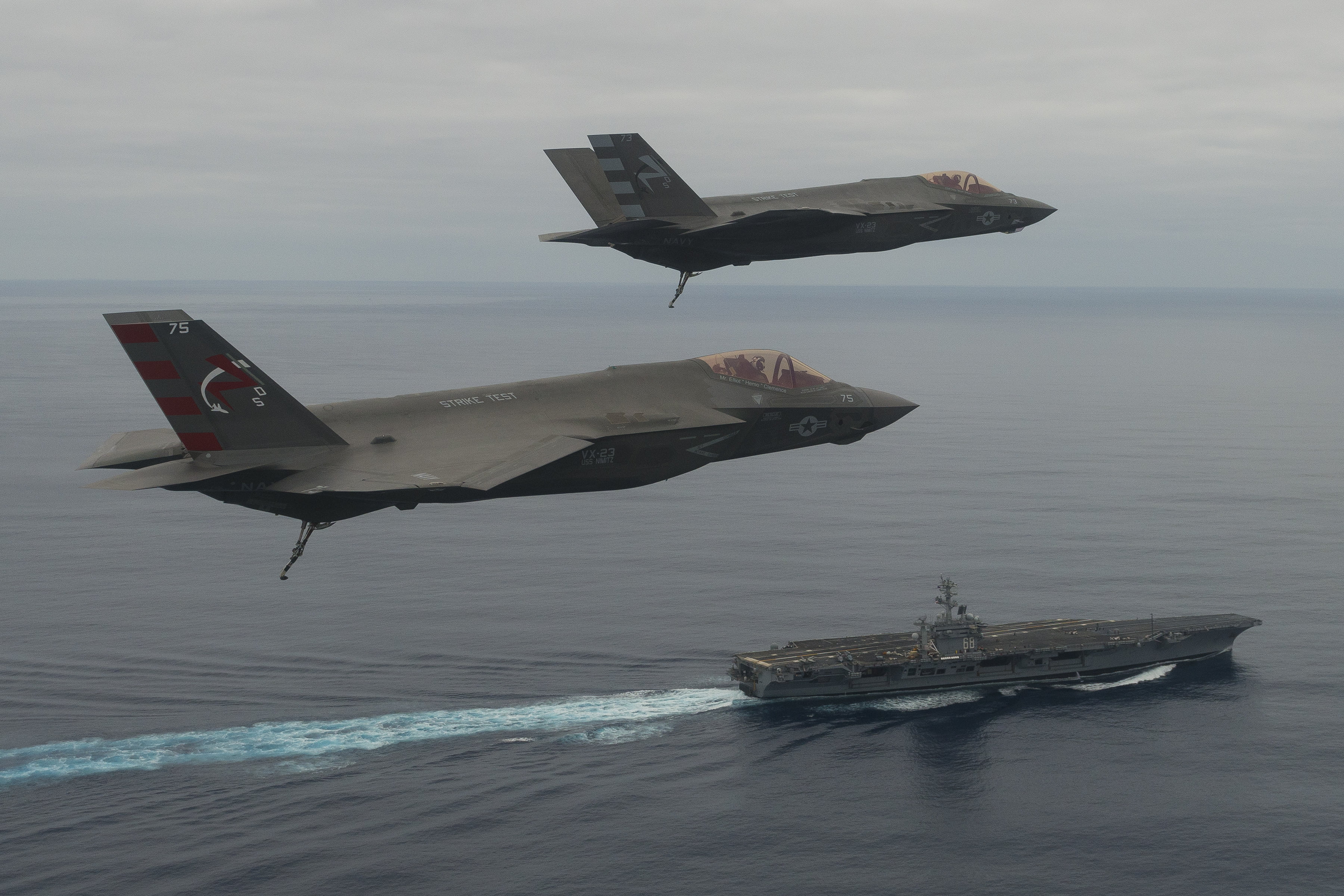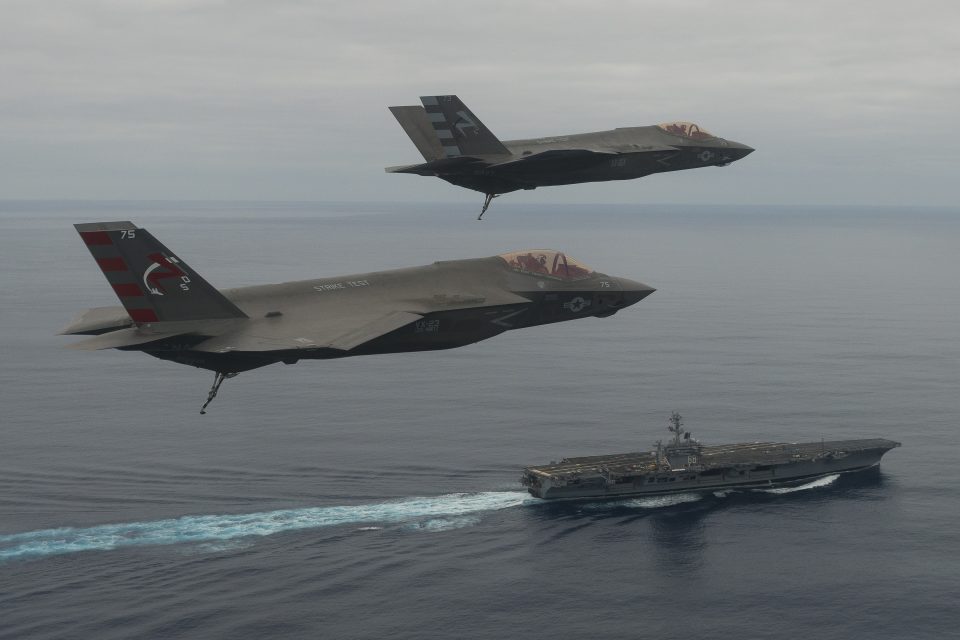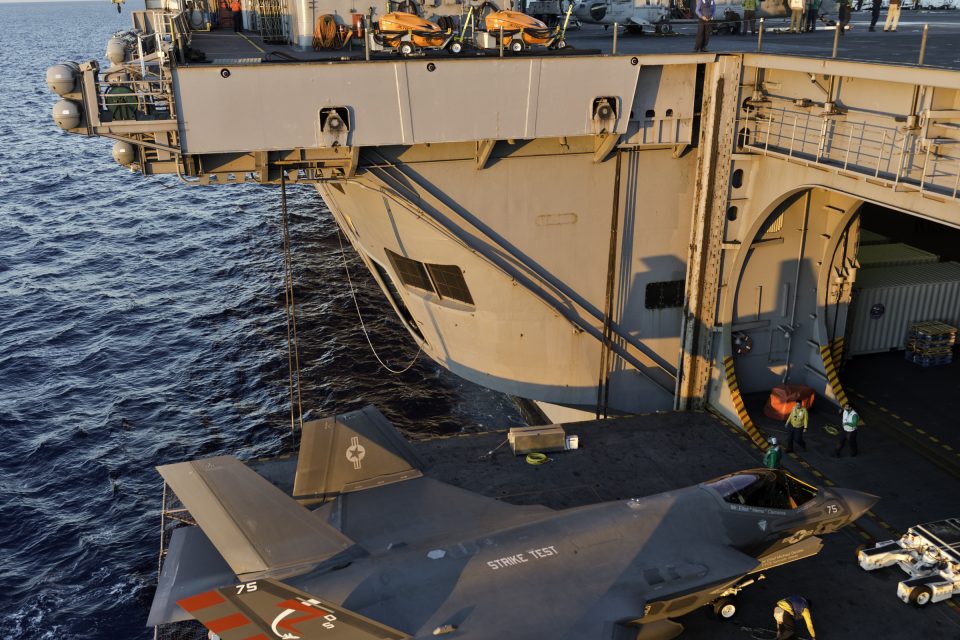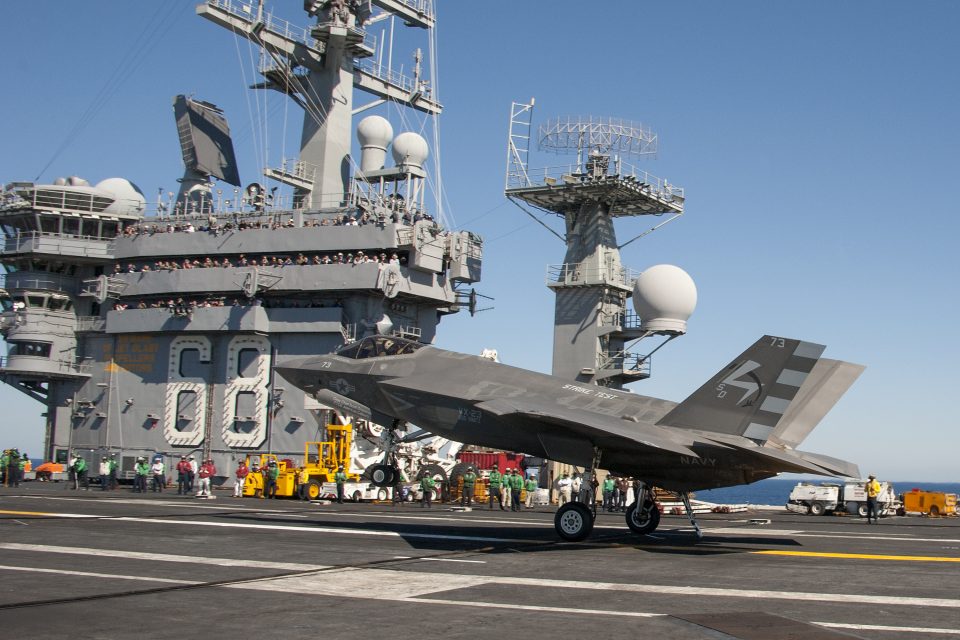2016-02-04 By Ed Timperlake and Robbin Laird
In a visit to Pax River on January 8, 2015, we had a chance to talk with members of the Integrated Test Team at Pax River, which includes Marines, Navy, Brits and civilians as well as contractors.
This team is wringing out the F-35C from the standpoint of its ability to operate on the carrier. The team looks at flying characteristics not the mission systems, which are tested at Edwards AFB.
Because the Navy pilots involved in the testing rotate from operational combat squadrons, discussions with them highlight the coming impact of the F-35C on the air wing as well.
They can discuss with expert authority the culture gap between the F-35C and the Hornet, the 4th Gen fighter/strike aircraft currently operational in all USN Carrier Air Wings.
As test pilots, having gone through very vigorous school and fleet operational experiences, they are uniquely qualified to understand the dynamics of change associated with the coming of the USN F-35 Lighting II into the fleet.
On this visit, we engaged with USN Test Pilots.
Our last visit was to engage with the USMC Test Pilots flying the F-35B. It should be noted that both Navy and Marine aviators wear the same Navy Wings of gold, and Marines —in addition to flying the F-35B — will also have USMC squadrons of F-35Cs on board Navy carriers.
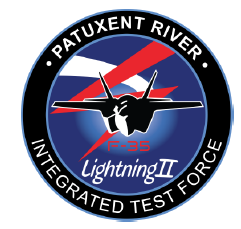
In this interview, we had a chance to discuss the results to date and the way ahead with LCDR Daniel “Tonto” Kitts, a VX-23 Test Pilot who is working on F-35C carrier suitability.
“Tonto” is now working as a test pilot focusing on carrier suitability, but he also has significant operational experience with the “Rhino,” otherwise known as the Super Hornet.
He was the det officer-in-charge (OIC) for the second phase of carrier landing testing in CVN DT-II and is preparing for CVN DT-III later this year.
Also participating in the interview was CDR Theodore “Dutch” Dyckman, a fleet combat pilot and now a VX-23 Test Pilot and the Pax River ITF Operations Officer.
CDR Dyckman flew in both DT-I and DT-II and is preparing for DT-III later this year.
We discussed a wide range of issues, which demonstrated the breadth of knowledge and experience of these two pilots, but the interview presented here focused on the demonstrated flying qualities of the F-35C and the perceived impact of those capabilities on carrier qualifications and operations.
We also touched on the significant gap between their experience and the broad perception that the Navy is reluctant to become an F-35 force, which is most definitely not true for these experienced combat pilots.
Question: Carrier landings are challenging.
They are dangerous and require a lot of training to get them right and to enhance the safety of the pilot, the crews, and the ship.
In fact, during the Vietnam War, there were tests done of carrier pilots’ heart rates which we actually higher when landing on a carrier than when being shot at over Hanoi.
How does the F-35 affect the landing challenges associated with trap and cat operations?
Answer: The plane flies very well.
The flying qualities are excellent and the machine systems built into the plane significantly enhance the ease of landing and taking off from the carrier.
Basically with the F-35 you get your mission cross-check time back.
Normally once you start the approach your scan is solely meatball, line up, and angle of attack. Your mission cross-check time behind the ship is zero because you’re just doing that scan.
With the F-35 and its enhanced flight controls and superb handling, the aircraft doesn’t deviate much from the desired flight path, which greatly eases the workload on the ball and frees up your scan.
It almost makes flying the ball a relaxing task.
Question: Ease of flying can clearly translate not just into safety but training time.
What do you see as the impact?
Answer: Before you go to the boat, everything stops in the squadron.
All training stops two to three weeks where all you’re doing is banging left-hand turns.
No one is doing any tactical training.
Everyone’s bandwidth is concerned with how they are landing at the ship.
Once you’ve been out on the ship for a few days and the landings are looking better, then finally you can start working on what we want to work on again tactically.
Where you’ve just taken a pause from all your tactical performance for the past nearly month, that’s going to go away with the F-35, which will allow you to be dedicated to your tactical performance.
Question: Clearly, the Super Hornet is an excellent airplane, but the F-35 is a very different aircraft with a different approach to air system operations.
How do you see the F-35 affecting tactical training?
Answer: With the current air wing (i.e, with the Super Hornet and Hornet as the tip of the spear), we are wringing out our tactics for a tactical advantage, which is also, at the same time, at the edge of the envelope for survival.
We are spending a lot of time making sure that we have the right tactics and the mastery of those tactics by pilots to survive and succeed.
It is about keeping a level of competence and capability where you’re not going to die.
There are points where you have a twenty second window.
You miss that window and you might be blown up.
When you’re traveling at those speeds, we are talking really only a couple of seconds that you have.
And, if you’re not performing tactics exactly as they’re prescribed, you put yourself in a kill zone.
With the F-35, we are jumping a generation in tactics and now looking at the expanded battlespace where we can expand our impact and effect.
You need to take a generational leap so we are the ones not playing catch up with our adversaries.
Question: Admiral Manazir talks about shaping greater reach for the carrier and your point is that with the coming of the F-35 your tactics will change?
Answer: That is correct and the air wings will rapidly recognize the impact as they get their squadrons of F-35s.
They will put in the rear view mirror all of the uninformed comments made by many people who do not know the aircraft and what it can do.
And what we see as testers will proliferate rapidly in the fleet as squadron pilots see the impact on their lethality and survivability.
Question: There clearly is a cultural challenge in the Navy in making the transition.
How do you view this transition as working out?
Answer: Navy leadership is clearly leading the charge, people like Admiral Manazir and other leaders.
Naval Aviation is clearly focused on integrated warfighting in the expanded battlespace.
The F-35 is a key part of that focus.
The air wings are not yet a key part of that transition, but when the planes get to the squadron, change will happen more rapidly than many people think.
Already, the first training squadron of F-35s came to Fallon for an exercise and that was an eye opener for Fallon.
The knowledge is there inside the Navy.
And, equally important, is getting it down to the user to understand what the airplane is going to do and to accept what’s already been designed to do.
That is the challenge.
Editor’s Note: There is another aspect of the impact of fifth generation systems on pilots, notably the new pilots who come directly into fifth generation systems.
A key point was made about an Aussie F-22 exchange pilot who is an experienced F/A-18 operator.
For RAAF Fighter Pilot Matthew Harper, the systems in the fifth generation aircraft, which take a giant leap forward with the F-35, provide the pilot with a decision making role, not an overburdened “look at your screens” and sort out what to do role.
He summarized the impact that he saw with three key examples:
First, within the first 30 minutes of sitting down in the simulator, he grasped that his ability to dominate the air space with the F-22 was clear.
Second, the abilities of the pilots are significantly augmented with fifth generation capabilities. He cited a recent example where a USAF pilot with only 350 total flight hours flew in Red Flag and dominated his airspace. For Harper, this would be virtually impossible to imagine in any other plane.
Third, he cited the experience of a USAF F-15C pilot who told him:
“I have more SA with only 20 hours on the F-22A than I ever had with over 1500 hours on the F-15C.”
The overarching point of the presentation was that the fifth generation experience was about disruptive change, not evolution. You needed to get into the fifth generation platform to experience the change and learn how to shape tactics and concepts of operations relevant to 21st century operations, rather than perfecting your 20th century piloting skills.
He went out of his way to compare the Super Hornet to the F-22A with a core focus on how the former was NO WAY the later. Whereas the F-22A was an SA and information dominance machine, the Super Hornet was a classic aircraft which had the limitations of any airplane not built from the ground up to be an information dominance aircraft for the 21st century battlespace.
While the Super Hornet is a significant upgrade from the Hornet, it is not and never will be able to deliver what a fifth generation aircraft can deliver: integrated data fusion and re-shaping the pilot and squadron roles in prosecuting air dominance and support to the joint force in the battlespace.
In short, the leap ahead is crucial; and reworking the culture of the RAAF will be necessary to leverage the disruptive technology built into fifth generation aircraft.
https://sldinfo.com/an-raaf-f-22-pilot-explains-the-dramatic-shift-to-fifth-generation/
Interviews done during our 2011 visit to Pax River:
https://sldinfo.com/fly-testing-the-f-35-a-building-block-approach/
https://sldinfo.com/the-f-35-mission-systems-a-game-changer-viewed-from-pax-river/
https://sldinfo.com/shaping-the-f-35-maintenance-approach/
https://sldinfo.com/an-update-on-f-35b-and-f35-c-testing/
https://sldinfo.com/the-f-35-pilot/
The slideshow highlights activities during DT-1 aboard the Nimitz and planes flown by CDR Dyckman are seen in operation.
The video shows activities during DT-2 last fall aboard the Eisenhower.


